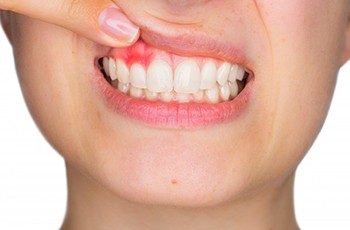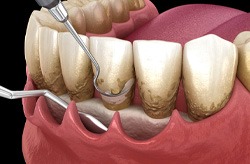Periodontal Therapy – Columbia, TN
Maintain a Healthy Home for Your Teeth

What’s the most common reason behind tooth loss in America? You might think it’s due to injuries or cavities, but it’s actually because of gum disease. Also known as periodontal disease, gum disease drastically increases your risk of tooth loss and other oral health problems. Even though more than half of adults in the United States will develop gum disease at some point in their lives, our team here at Beck Dental Care of Columbia can help treat it with periodontal therapy in Columbia, TN. Contact us today to learn more about this treatment and how it can help you maintain a healthy home for your teeth.
What Is Gum Disease?

Gum disease is a bacterial infection within the gum tissue. It can appear in one of several stages, all of which present their own symptoms and dangers. When the gums are attacked by acids produced by the bacteria in dental plaque, the tissue becomes irritated and inflamed, causing it to bleed easily. Unless this condition is treated, the infection can spread to the entirety of your gum tissue, resulting in sensitive or tender gums, bleeding when brushing or eating, receding gums, or even tooth loss.
Even though gum disease is one of the most common chronic infections in the world, that doesn’t mean that it can’t be treated. If your dentist in Columbia catches it in the early stages, it can even be reversed. Furthermore, even the advanced stages of gum disease can be treated with skilled, personalized treatment from our dentists.
Symptoms of Gum Disease

One of the most dangerous aspects of gum disease is the fact that it sometimes doesn’t present noticeable symptoms until it has already done serious damage. However, there are a few telltale signs you should watch out for. Give us a call if you notice any of the following symptoms:
- Bleeding while brushing, flossing, or chewing hard foods
- Gums that are swollen, tender, red, or dark purple
- Receding gum tissue that makes your teeth look longer than normal
- Mouth sores
- Persistent bad taste in your mouth
- Chronic bad breath that doesn’t subside even after brushing
- Changes in the way your teeth fit together
- Teeth that begin to shift or feel loose
- Pus forming in between your gums and teeth
In the earliest stage of gum disease, called gingivitis, you may notice bleeding after brushing or flossing. However, in some cases, this is a sign that you’re not flossing enough and should subside after a few days. If it doesn’t, call our dental office right away.
How We Can Treat Gum Disease

The earliest stage of gum disease, gingivitis, can often be reversed with improved at-home care. However, the more advanced stages typically require in-office gum disease treatment. The most common and conservative procedures we offer are known as scaling and root planing.
First, we administer a local anesthetic to numb you up and maximize your comfort for the duration of your stay with us. During the scaling portion, we use special instruments to break up and remove plaque and tartar that have attached themselves to your gums and tooth roots. Then, in the root planing portion, we smooth out the roots, removing the remainder of the bacteria from those areas. This treatment also makes it significantly more difficult for plaque to build up in the future.
Scaling & Root Planing

Gum disease is unfortunately quite common, and while many patients can sufficiently handle the condition on their own, professional intervention is sometimes necessary. This usually takes the form of scaling and root planing.
These procedures are done to remove stubborn plaque and tartar deposits that can contribute to gum disease. If you’re interested in learning more, here’s what you should know about these common treatments.
Read More About Scaling & Root Planing
Do I Need Scaling & Root Planing?

There are many different indicators for gum disease that suggest to a dentist that you might require scaling or root planing. For example:
- Bleeding while brushing or flossing
- Swollen, inflamed gums
- Gum recession
- Visible plaque deposits
- Chronic bad breath
When these conditions are mild, it could be that you have only the beginnings of gum disease, known as gingivitis. This can usually be remedied with improved dental hygiene. If the symptoms are severe, you might be suffering from a more advanced form of gum disease called periodontitis. This is when scaling and root planing become necessary.
The Process of Scaling & Root Planing

The process of scaling and root planing happens in two parts, often across separate appointments. In the case of both procedures, we will numb your mouth completely before we begin.
First, the scaling: we will make use of a specialized instrument called a “scaler” to remove any visible plaque or tartar deposits. This involves cleaning both the surface of the tooth and the pockets just below the gum line.
Then, the root planing: This involves removing hardened bacterial deposits that have attached themselves to the root tissue far below the gumline. This makes it less likely that your gums will become infected again.
Aftercare Tips for Scaling & Root Planing

Scaling and root planing can be a little bit intense, so it’s common for patients’ gums to need a few weeks to recover fully. While you won’t be out of commission, you may be a little bit tender during this period.
You can make this a bit easier on yourself by keeping a few simple aftercare tips in mind. First of all, remember to be gentle when brushing after this treatment; make sure that you’re using a soft-bristled toothbrush, and slowly move it in circular motions in order to clean your teeth. You may also want to rinse your gums with warm saltwater after eating, as this can make cleaning a bit easier.
You might want to stick to a soft food diet for the first 48 hours after your treatment. After that, you should still stay away from foods that could irritate your gums (spicy foods, alcohol, acids) for a few weeks more.
Once aftercare is complete, you’ll be able to enjoy the freedom and comfort that comes with a perfectly healthy smile!


